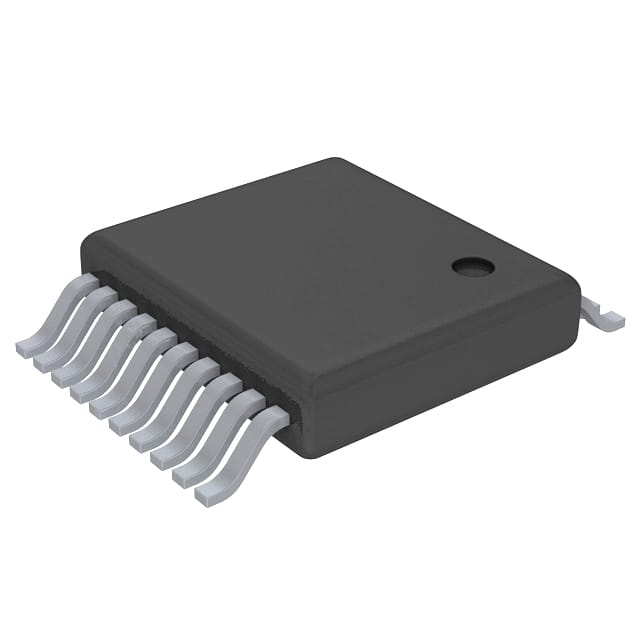SN74LV244ATDGVR
Product Overview
- Category: Integrated Circuit (IC)
- Use: Buffer/Line Driver
- Characteristics: Low-voltage, Octal Bus Buffer with 3-State Outputs
- Package: TSSOP (Thin Shrink Small Outline Package)
- Essence: The SN74LV244ATDGVR is a high-performance buffer and line driver IC designed for low-voltage applications.
- Packaging/Quantity: Tape and Reel, 2500 units per reel
Specifications
- Supply Voltage Range: 1.65V to 5.5V
- Input Voltage Range: 0V to VCC
- Output Voltage Range: 0V to VCC
- Maximum Operating Frequency: 100MHz
- Number of Channels: 8
- Output Current: ±24mA
- Propagation Delay Time: 4.2ns (typical)
- Operating Temperature Range: -40°C to +85°C
Detailed Pin Configuration
The SN74LV244ATDGVR has a total of 20 pins, which are assigned as follows:
- Pin 1: Output Enable (OE) 1
- Pin 2: A1
- Pin 3: Y1
- Pin 4: A2
- Pin 5: Y2
- Pin 6: A3
- Pin 7: Y3
- Pin 8: GND (Ground)
- Pin 9: Y4
- Pin 10: A4
- Pin 11: Y5
- Pin 12: A5
- Pin 13: Y6
- Pin 14: A6
- Pin 15: Y7
- Pin 16: A7
- Pin 17: Y8
- Pin 18: OE2
- Pin 19: VCC (Supply Voltage)
- Pin 20: GND (Ground)
Functional Features
The SN74LV244ATDGVR offers the following functional features:
- Octal Buffer/Line Driver: It provides eight independent buffer and line driver channels, allowing bidirectional data flow.
- 3-State Outputs: The outputs can be put into a high-impedance state using the Output Enable (OE) pins, enabling multiple devices to share a common bus.
- Low-Voltage Operation: Designed for low-voltage applications, it operates within a supply voltage range of 1.65V to 5.5V.
- High-Speed Performance: With a maximum operating frequency of 100MHz, it ensures fast data transmission.
- Robust Design: The IC is built to withstand harsh environmental conditions, with an operating temperature range of -40°C to +85°C.
Advantages and Disadvantages
Advantages: - Wide supply voltage range allows compatibility with various systems. - High-speed performance enables efficient data transfer. - 3-state outputs facilitate bus sharing among multiple devices. - Robust design ensures reliability in challenging environments.
Disadvantages: - Limited number of channels may not be suitable for applications requiring a higher number of buffers. - Propagation delay time may affect real-time applications that demand faster response times.
Working Principles
The SN74LV244ATDGVR functions as a buffer and line driver by amplifying and shaping input signals to provide robust output signals. It operates based on the principles of digital logic, where the input signals are processed and transmitted through the internal circuitry to the corresponding output channels. The Output Enable (OE) pins control the state of the outputs, allowing them to be either active or in a high-impedance state.
Detailed Application Field Plans
The SN74LV244ATDGVR finds applications in various fields, including:
- Microcontrollers: It can be used to interface microcontrollers with external devices, such as sensors, actuators, and displays.
- Communication Systems: The IC enables signal buffering and line driving in communication systems, ensuring reliable data transmission.
- Industrial Automation: It is suitable for controlling and monitoring devices in industrial automation applications, providing signal conditioning and isolation.
- Automotive Electronics: The low-voltage operation and robust design make it ideal for automotive electronics, including vehicle control systems and infotainment systems.
Detailed and Complete Alternative Models
- SN74LV244A: Similar to SN74LV244ATDGVR but available in different package options.
- SN74LVC244A: A similar octal buffer/line driver with 5V-tolerant inputs, suitable for mixed-voltage systems.
- SN74HCT244: A high-speed CMOS octal buffer/line driver with 3-state outputs, compatible with TTL logic levels.
These alternative models offer similar functionality and can be considered based on specific requirements and availability.
Word count: 536 words
Senaraikan 10 soalan dan jawapan biasa yang berkaitan dengan aplikasi SN74LV244ATDGVR dalam penyelesaian teknikal
Sure! Here are 10 common questions and answers related to the application of SN74LV244ATDGVR:
Q: What is SN74LV244ATDGVR? A: SN74LV244ATDGVR is a specific type of integrated circuit (IC) known as a buffer/line driver. It is commonly used for signal amplification and level shifting in digital circuits.
Q: What is the voltage supply range for SN74LV244ATDGVR? A: SN74LV244ATDGVR operates with a voltage supply range of 1.65V to 5.5V.
Q: How many channels does SN74LV244ATDGVR have? A: SN74LV244ATDGVR has 8 channels, which means it can handle 8 separate input/output signals.
Q: What is the maximum output current of SN74LV244ATDGVR? A: The maximum output current per channel of SN74LV244ATDGVR is typically around 12mA.
Q: Can SN74LV244ATDGVR be used for bidirectional communication? A: No, SN74LV244ATDGVR is a unidirectional buffer/line driver, meaning it can only amplify signals in one direction.
Q: What is the propagation delay of SN74LV244ATDGVR? A: The propagation delay of SN74LV244ATDGVR is typically around 5.8ns.
Q: Is SN74LV244ATDGVR compatible with TTL logic levels? A: Yes, SN74LV244ATDGVR is designed to be compatible with both TTL and CMOS logic levels.
Q: Can SN74LV244ATDGVR handle high-speed data transmission? A: Yes, SN74LV244ATDGVR is capable of handling high-speed data transmission up to several hundred megahertz.
Q: What is the package type for SN74LV244ATDGVR? A: SN74LV244ATDGVR comes in a small surface-mount package known as TSSOP-20.
Q: What are some typical applications for SN74LV244ATDGVR? A: SN74LV244ATDGVR is commonly used in various technical solutions such as bus drivers, memory address drivers, and general-purpose level shifting applications.
Please note that the answers provided here are general and may vary depending on specific datasheet specifications and application requirements.


